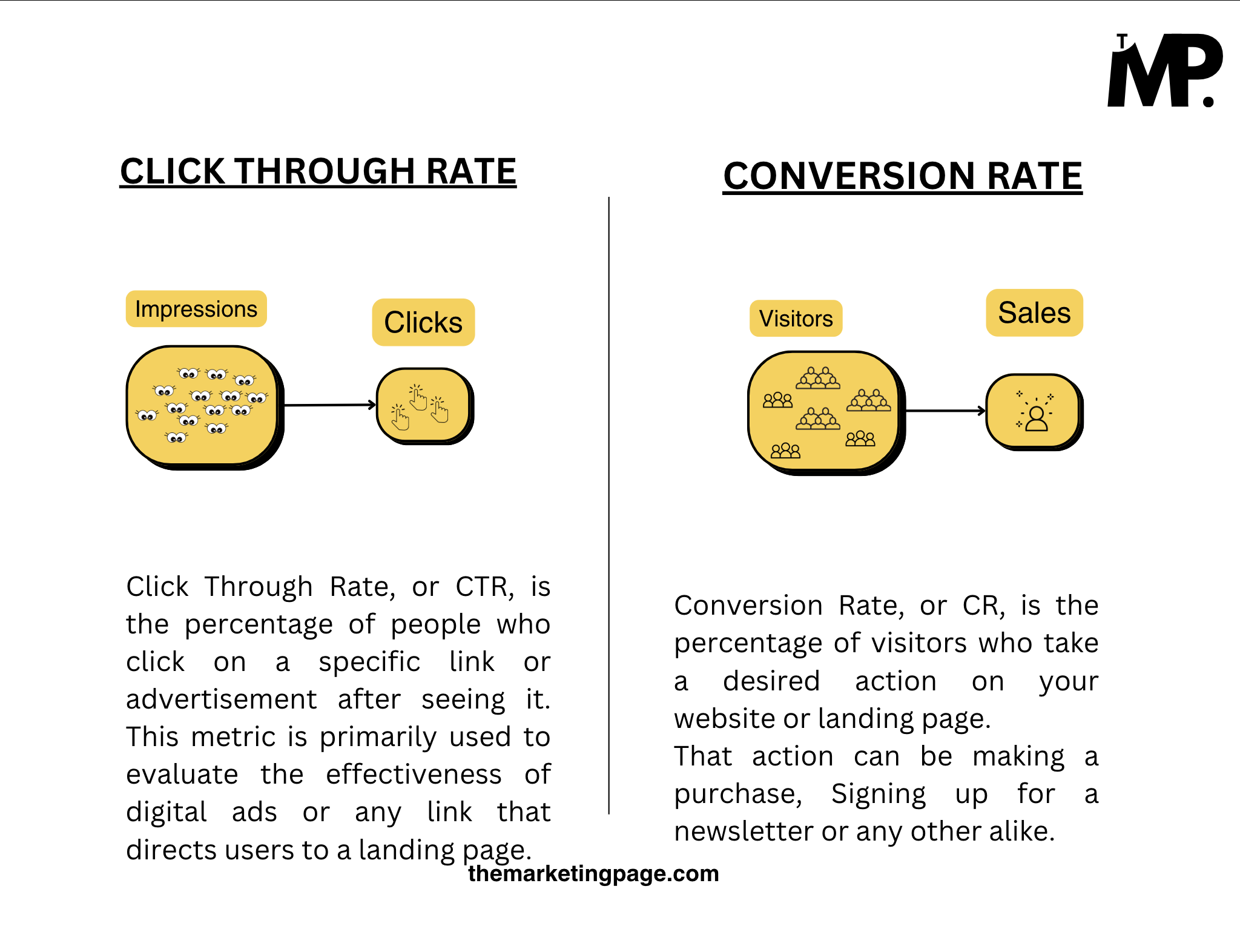CTR vs. CR – These metrics serve as essential indicators of how well your marketing efforts are performing, but they measure different stages in the customer journey.
In digital marketing, two key metrics often come up when evaluating the effectiveness of online campaigns: Click Through Rate (CTR) and Conversion Rate (CR).
What is Click Through Rate (CTR)?
Click Through Rate, or CTR, is the percentage of people who click on a specific link or advertisement after seeing it.
This metric is primarily used to evaluate the effectiveness of digital ads, email campaigns, or any link that directs users to a landing page.
CTR helps measure how engaging or appealing your content or advertisement is to your audience.
Formula for click through rate
CTR = (Total Clicks on Ad / Total impressions) x 100
Where:
Total Impressions = The number of times your ad or link was displayed.
Total Clicks on Ad or Link = The number of times users clicked on your ad or link.
Example calculation
If you are running a Google Ads campaign. You received 500 clicks on your ad and 10,000 impressions.
CTR = (500 / 10,000) x 100
So, your Click Through Rate (CTR) is 5%.
What Does CTR Tell You?
CTR tells you how effective your ad, email, or link is at getting people’s attention.
A high CTR means your audience is engaged and intrigued enough to click, while a low CTR indicates that your messaging, visuals, or targeting might not resonate with your audience.
It’s a great first indicator of the appeal of your campaign.
What is Conversion Rate (CR)?
Conversion Rate, or CR, is the percentage of visitors who take a desired action on your website or landing page.
That action can be;
- Making a purchase
- Signing up for a newsletter
- Downloading an ebook
Conversion rate is a critical metric for measuring the effectiveness of a marketing campaign in driving valuable actions.
Formula for conversion rate
CR = (Total Conversions / Total Visitors) x 100
Where:
Total Visitors = The number of people who visited your website or landing page.
Total Conversions = The number of people who completed the desired action (e.g., making a purchase).
Example calculation
CR = (Total Conversions / Total Visitors) x 100
Where:
Total Visitors = The number of people who visited your website or landing page.
Total Conversions = The number of people who completed the desired action (e.g., making a purchase).
What Does Conversion Rate Tell You?
Conversion Rate measures how successful your ad is at encouraging visitors to take a desired action.
A high conversion rate indicates that your offer and website are compelling enough to motivate visitors to act, while a low conversion rate may suggest that your landing page, offer, or follow-up process needs optimization to boost user action.
Key Differences Between Click Through Rate (CTR) and Conversion Rate (CR)
| Aspect | Click Through Rate (CTR) | Conversion Rate (CR) |
|---|---|---|
| Definition | Measures how many people click on an ad or link after seeing it. | Measures how many visitors complete a desired action. |
| Stage in Funnel | Early stage (awareness or interest) | Later stage (decision or action) |
| Formula | CTR = (Total Clicks on Ad / Total impressions) x 100 | CR = (Total Conversions / Total Visitors) x 100 |
| Primary Focus | Engagement with the ad, link, or content. | The effectiveness of turning visitors into customers or leads. |
| What it Measures | The level of interest in your ad or content. | The effectiveness of your website or landing page in driving action. |
| Action Required | Clicking on an ad or link. | Completing a goal (purchase, sign-up, download, etc.). |
| Impact on Sales | Indirect impact (leads to traffic). | Direct impact (drives conversions and revenue). |
| Value Indication | High CTR: Indicates that your content is engaging and well-targeted. Low CTR: Indicates a lack of interest or poor targeting. | High CR: Indicates that your landing page or offer is effective at turning visitors into leads or customers. Low CR:Suggests that users are not taking the desired action or that the offer/page needs optimization |
| Conversion Path | Measures only the initial step (click). | Measures the final step (desired action). |
| Optimization Goal | Increase click-through to drive more traffic. | Optimize the site/offer to increase the percentage of conversions. |
| Tools to Measure | Google Ads, Social Media Analytics, Email Campaigns. | Google Analytics, Conversion Tracking Tools, E-commerce Platforms. |
Also Read Sales funnel vs. Marketing funnel – What’s the difference?
Conclusion: How to Use CTR and CR Together
CTR can help you understand if your ads or content are engaging enough to get clicks, while CR tells you whether those clicks lead to meaningful actions.
By analyzing both metrics together, you can make more informed decisions to improve your campaigns.

2 Comments